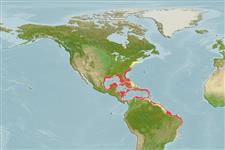Environment: milieu / climate zone / depth range / distribution range
Ökologie
seewasser riff-verbunden; tiefenbereich 3 - 200 m (Ref. 26938). Subtropical; 42°N - 18°S, 98°W - 34°W
Western Atlantic: Rhode Island (USA), Bermuda, and northern Gulf of Mexico southward to Brazil. Most abundant in the West Indies (Ref. 9626).
Length at first maturity / Size / Gewicht / Alter
Maturity: Lm 36.0, range 30 - 42 cm
Max length : 76.0 cm FL Männchen/unbestimmt; (Ref. 40637); common length : 54.0 cm TL Männchen/unbestimmt; (Ref. 3815); max. veröff. Gewicht: 10.6 kg (Ref. 4699)
Rückenflossenstacheln (insgesamt): 12; Rückenflossenweichstrahlen (insgesamt): 12; Afterflossenstacheln 3; Afterflossenweichstrahlen: 10. Blue line under each eye. Corner of mouth and isthmus have orange cast (Ref. 26938). An irregular row of small molariform teeth inside and toward the front of the three usual rows of molars at side of upper jaw; dorsal profile of head evenly convex and not very steep (Ref. 13442).
Inhabits coastal waters. Found on vegetated sand bottoms and more frequently on coral bottoms. Occasionally found at depths at least 180m (Ref. 09710) and 200 m. (Ref. 26938). Large adults are usually solitary. Feeds mainly on sea urchins, (including Diadema, Ref. 13442), crabs and mollusks. Excellent food fish (Ref. 5521).
Robins, C.R. and G.C. Ray, 1986. A field guide to Atlantic coast fishes of North America. Houghton Mifflin Company, Boston, U.S.A. 354 p. (Ref. 7251)
IUCN Rote Liste Status (Ref. 130435)
Bedrohung für Menschen
Reports of ciguatera poisoning (Ref. 9710)
Nutzung durch Menschen
Fischereien: weniger kommerziell; Sportfisch: ja
Mehr Information
ReferenzenAquakulturAquakultur ProfilZuchtlinienGenetikElectrophoresesVererbbarkeitKrankheitenVerarbeitungNutrientsMass conversion
PartnerBilderStamps, Coins Misc.LauteCiguateraGeschwindigkeitSchwimmstilKiemenoberflächeOtolithsGehirngrößeSehfähigkeit
Tools
Zusatzinformationen
Download XML
Internet Quellen
Estimates based on models
Preferred temperature (Ref.
123201): 18.6 - 27.5, mean 24.3 °C (based on 261 cells).
Phylogenetic diversity index (Ref.
82804): PD
50 = 0.5001 [Uniqueness, from 0.5 = low to 2.0 = high].
Bayesian length-weight: a=0.02630 (0.01684 - 0.04108), b=2.92 (2.79 - 3.05), in cm total length, based on LWR estimates for this species & Genus-body shape (Ref.
93245).
Trophic level (Ref.
69278): 3.5 ±0.2 se; based on diet studies.
Widerstandsfähigkeit (Ref.
120179): mittel, Verdopplung der Population dauert 1,4 - 4,4 Jahre. (tm=3).
Fishing Vulnerability (Ref.
59153): Moderate to high vulnerability (54 of 100).
Nutrients (Ref.
124155): Calcium = 18.2 [7.6, 38.0] mg/100g; Iron = 0.493 [0.250, 1.048] mg/100g; Protein = 20 [19, 21] %; Omega3 = 0.176 [0.096, 0.330] g/100g; Selenium = 23.3 [10.6, 48.9] μg/100g; VitaminA = 22.5 [5.2, 98.7] μg/100g; Zinc = 0.56 [0.34, 0.85] mg/100g (wet weight);
